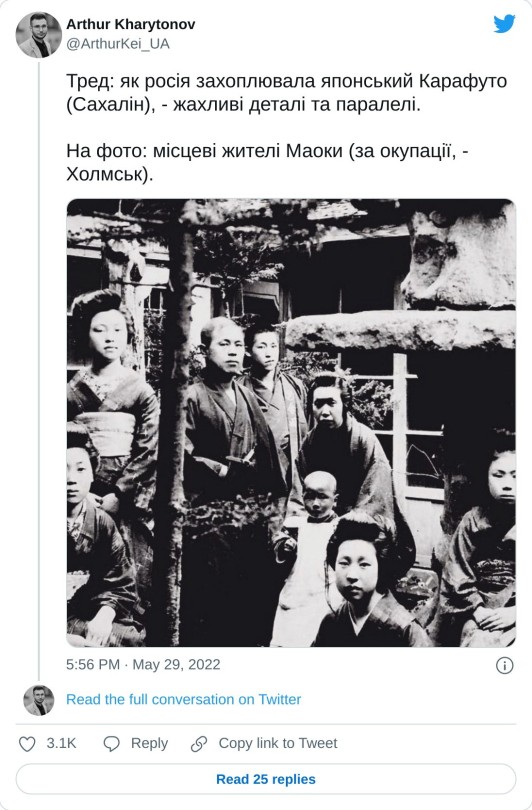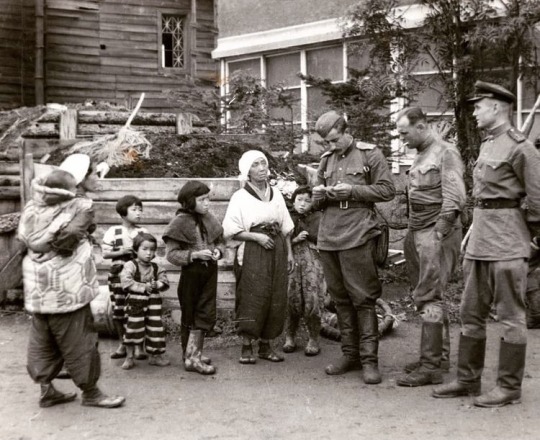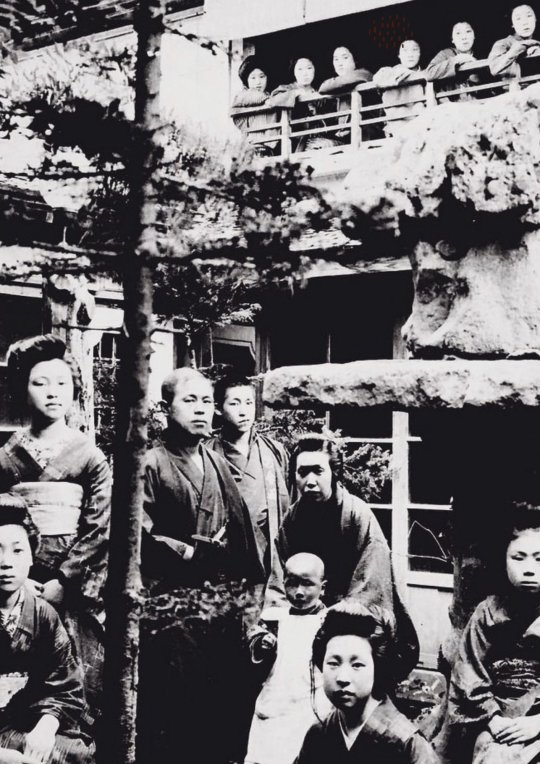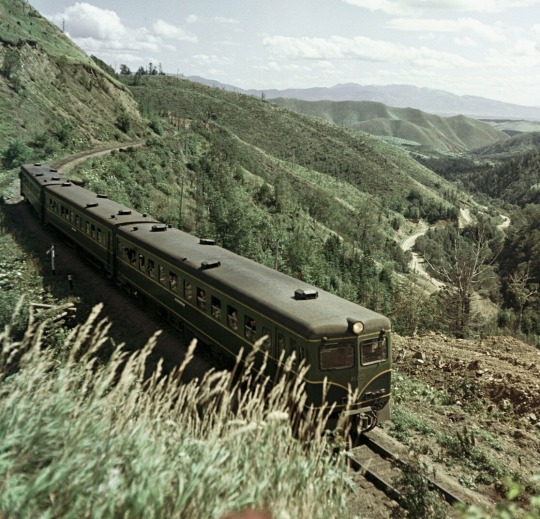#kholmsk
Explore tagged Tumblr posts
Photo

ТУРПОЕЗДКА ПО САХАЛИНУ НА РЕЛЬСОВОМ АВТОБУСЕ / SAKHALIN TOUR BY RAIL BUS Впервые за последние почти 25 лет на железнодорожной линии, проложенной между сахалинскими городами Невельск и Холмск началось пассажирское сообщение. Накануне по этому направлению в рамках прогулочной турпоездки совершил коммерческий рейс рельсовый автобус "Орлан". Подробности на @laikainfo ➡️ www.laikainfo.com For the first time in almost 25 years, passenger traffic has started on the railway line between the Sakhalin cities of Nevelsk and Kholmsk. Recently, the Orlan rail bus made a commercial flight in this direction as part of a walking tour. _______ #железнаядорога #сахалин #Невельск #Холмск #пассажирскоесообщение #турпоездка #рельсовыйавтобус #Орлан #внутреннийтуризм #туризм #поезд #пригородноесообщение #путешествия #остров #природа #railway #Sakhalin #Nevelsk #Kholmsk #passengerservice #touristtrip #railbus #Orlan #domestictourism #tourism #train #commuterservice #travel #island #nature (at Сахалин) https://www.instagram.com/p/CFFj7LhgTXB/?igshid=zyikr2sbldlt
#железнаядорога#сахалин#невельск#холмск#пассажирскоесообщение#турпоездка#рельсовыйавтобус#орлан#внутреннийтуризм#туризм#поезд#пригородноесообщение#путешествия#остров#природа#railway#sakhalin#nevelsk#kholmsk#passengerservice#touristtrip#railbus#orlan#domestictourism#tourism#train#commuterservice#travel#island#nature
0 notes
Photo







0 notes
Photo

sea scape at Kholmsk
1 note
·
View note
Photo

The return of the rescuer. by HariesAutoMoto
#port#air#beauty#breeze#cleanliness#clouds#cold colour#cool crunch#frost#glacier#gulls#ice#kholmsk#la
0 notes
Photo

I will be miss this winter weather🙌🏽 #sakhalin #traveling #travelblogger #russian #kholmsk (at Kholmsky District, Sakhalin Oblast)
3 notes
·
View notes
Photo

Oji Paper’s former Maoka Mill, Kholmsk, 2012. Photography by Tomoko Yoneda.
583 notes
·
View notes
Text

A thread: how russia captured the Japanese Karafuto (Sakhalin) - terrible details and parallels.
In the photo: locals of Maoka (during the occupation - Kholmsk).
In this post I want to share the details of the course of russian enslavement of Karafuto, which I found while working on other contexts. But first, basic information is needed:
1) Karafuto and the Kuriles were important parts of Japan, with a developed Japanese infrastructure, culture and traditions. The population was about half a million.
2) russian invasion of Karafuto and Chishima began on August 11, 1945, five days after the nuclear bombing of Hiroshima and three days after a similar attack on Nagasaki, the de facto surrender of Japan (surrender on August 15). Karafuto and Chishima had small Japanese forces but large numbers of civilians and refugees from other Japanese islands. Russia, in turn, pathetically attacked the state, which had already surrendered - after the defeat by United States and its allies.
Now for the details of the occupation of Karafuto (the island was occupied on August 25, 1945, the Japanese of Karafuto held out under russian civilian bombing and terror for 14 days).
I came across a scientific paper from the law school of occupied Karafuto on how the russians organized "law and order and the fight against crime" on the island from 1945 to 1950.
Then - on points.
1. By the end of August 1945, russians were persecuting civilians south of Karafuto, about 70,000 people whom the occupying scholars call "a highly dangerous human mass." During the offensive, russians destroyed communications lines, transportation, livestock and Japanese businesses.
2. russians were not clearly explained that they had come to "russian lands", which led to "senseless destruction" [rus] of infrastructure, temples, as well as mass theft of industrial equipment, property of enterprises and organizations, as well as civilian property.
3. In mid-September 1945, it became known that russians had stolen all stocks of Japanese sake at Karafuto (202,457 decalitres); this led to mass drunkenness among the occupying military, ie terror against the local population.
4. In the autumn of 1945, the yen and all trade in Karafuto ceased, and russians began to provide services and goods to the occupiers free of charge (they later officially accused the Japanese of embezzlement). Curfew from 5:00 to 20:00 was imposed by orders from the mainland. The free movement of the Japanese was generally forbidden: it was controlled by the military commandant's offices of the occupiers.
6. In the first months of the occupation, there were no police on the island: russians demobilized the local occupation forces and transferred them to the NKVD. This led to even more mass terror of the locals. Professional chekists began arriving on the island from the mainland in November 1945 (473 people).
7. The Japanese, who remained loyal to the state, continued to resist the occupation, much to the dismay of russians. In particular, they organized a system of ammunition depots, military bases and other "hiding places", probably in anticipation of help. Unfortunately, help did not come.
8. russians joined the search for Japanese shelters by involving local Koreans (who thought they would be allowed to return to Korea; they were not allowed to). In the spring of 1946, an incident occurred: the Koreans led russians to Japanese warehouses disguised in the woods with a large number of small arms, ammunition, etc.
9. By January 1947, chekists had stolen 556 rifles, 21 machine guns, 5 mortars, 2 grenade launchers, 32 pistols, and a large number of melee weapons (probably katanas), ammunition, and explosives from the Japanese underground in various ways.
Lt. Col. Chikushi Fujio, who served as deputy chairman of the Tajik taboo on Karafuto, as well as Captain Kitayama, staged a sabotage in the city of Shisuka (Poronaysk), destroying Japanese infrastructure so that it would not serve the occupiers. The losses amounted to 6.6 million soviet rubles. [about 436 million US dollars]
11. The Japanese Yamada, who could not survive the occupation nationalization, destroyed (probably his own) a warehouse with rice, a hotel, as well as stocks of forest products, which russians have already managed to call "Sakhalinlesderevo" [SakhalinForestWood].
11.1. A former Kikuchi police officer organized a sabotage group that killed three pro-russian Korean traitors. The group had 86 rifles and 7050 rounds in total.
12. occupiers tried to fight the underground by creating "civilian security teams" consisting of russians and koreans. It is noted that the activities of these groups were not effective.
13. On February 2, 1946, USSR decided to forcibly passportize the population of Karafuto. They managed to "capture" only half of the total Japanese population of Karafuto (because half, at the cost of military lives, were able to evacuate to Japan). Among these: 254,299 Japanese, 24,774 Koreans, 79 Chinese, 152 Ainu.
14. During this period, russians began the mass import of russian civilians to Karafuto, and in parallel - the repatriation of the Japanese. It is noted that the Japanese left on the island all property and all life: valuables, real estate, etc. Many were robbed by russians on their way to Japan.
Russian repatriation commissioners engaged in corruption: enriching themselves at the expense of the Japanese, demanding bribes and robbing civilians. Actively settled in Japanese houses. Observing the crimes, the Japanese resorted to intensifying sabotage: burning their homes, jobs, etc.
16. It is noted that russian army in Karafuto was generally full of criminals. In particular, soviet soldiers simply left the units, drank heavily, and committed crimes with extreme cruelty. Among them - robbery, looting, infliction of grievous bodily harm to the Japanese, murder.


More details
6 notes
·
View notes
Photo

Diesel train going from Yuzhno-Sakhalinsk to Kholmsk (Russian Far East), 1961
2K notes
·
View notes
Photo

Со 150летием, мой родной город🥳🎉💖 Скучаю и люблю всем сердцем❤️ #annshorr_sakhalin #annshorr_summer2017 (at Kholmsk) https://www.instagram.com/p/CD6f5MFKs62/?igshid=j4tf4u8864eh
1 note
·
View note
Photo










Kholmsk 2017
#ippeifujinaka#photographer#travel#landscape#portrait#Kholmsk#mayka#sakhalin#Russia#chimney#seascape#factory#ruins#lighthouse
0 notes
Photo

💁🏼🙋🏼🙅🏼🤦🏼♀️ #sakhalin #kholmsk #travelblogger #traveling (at Kholmsky District, Sakhalin Oblast)
4 notes
·
View notes
Photo

4th microdistrict of the Kholmsk City, Pervomayskaya Street 11, Kholmsk, Russia. Construction started in 1979 Chief Architect: Evgeny Yakovlevich Levitsky Contribuitor: @sozgorod #_ba_cu . . Map location: http://socheritage.com/ . . Add new sites: http://socheritage.com/add-locations-visitors/ . . Use the #SocialistModernism tag for the possibility to have your #SocHeritage shots featured. All information thus collected will be published on our website. https://www.instagram.com/p/BsaVP-iHCOM/?utm_source=ig_tumblr_share&igshid=v01y4347p62n
65 notes
·
View notes
Text
Vũng nước mưa nổi tiếng nhất nước Nga

Không chỉ có tên riêng, vũng nước mưa ở vùng Viễn Đông còn có tài khoản Instgram riêng thu hút đông đảo người hâm mộ.
Thành phố Yuzhno-Sakhalinsk vùng Viễn Đông có một vũng nước khổng lồ nổi tiếng nhất nước Nga. Vũng nước ban đầu chỉ là một ổ gà nhỏ, dần dần "mở rộng" và trở thành một vũng nước đọng lớn sau mỗi cơn mưa từ năm 1994.
Năm 2014, người dân địa phương yêu cầu chính quyền san lấp ổ gà này để loại bỏ mọi phiền toái một lần và mãi mãi. Tuy nhiên, kế hoạch sửa chữa bị trì hoãn nhiều lần kể từ đó.

Vũng nước nằm cạnh nhà số 10 phố Tikhookeanskaya, thành phố Yuzhno-Sakhalinsk. Ảnh: Instagram
Nikolay, một người cư dân trong khu phố, quyết định tạo một trang Instagram cho ổ gà này vào tháng 9/2020. Tài khoản Instagram có tên gọi @ya_luzha_u_doma (Tôi là vũng nước cạnh ngôi nhà), nhanh chóng trở nên nổi tiếng với hơn 3.000 người theo dõi chỉ trong 4 ngày.
Tài khoản Instagram của vũng nước giới thiệu: "Tôi là một vũng nước gần ngôi nhà số 10 phố Thái bình dương (Tikhookeanskaya) tại thành phố Yuzhno-Sakhalinsk. Tôi đã bước sang tuổi 25 và đủ trưởng thành để có tài khoản Instagram của mình".
Một tuần sau đó, vũng nước trở thành "ngôi sao" trên mạng của nước Nga, thu hút sự quan tâm của các phương tiện truyền thông. Nó được miêu tả là "bất khả chiến bại" khi tồn tại trong 25 năm. Tài khoản đến nay thu hút hơn 16.400 người theo dõi, với tất cả 59 hình ảnh chụp về vũng nước, "đính kèm" theo đó là các nội dung châm biếm một cách dí dỏm.
Sau mỗi trận mưa lớn, vũng nước lại mở rộng hơn và xuất hiện trên mạng xã hội với diện mạo mới. "Mọi người nhớ tôi không? Tôi nhớ mọi người. Hôm nay là một ngày mưa tuyệt vời, vì vậy nếu ai đó muốn đến gặp tôi, tôi sẵn lòng chào đón" là một trong những bài đăng trên tài khoản của vũng nước.

Vào cuối tháng 10/2020, vũng nước 25 tuổi đón rất nhiều du khách ghé thăm, phần lớn là YouTuber và những người có tầm ảnh hưởng trên mạng. Vũng nước đã yêu cầu chính quyền thêm tên nó vào danh sách điểm du lịch địa phương. Ảnh: Instagram
Vào tháng 11/2020, chính quyền thành phố rút cạn nước ở đây và lấp ổ gà lại bằng cát. Nhiệt độ mùa đông giảm dần, điều đó giúp nó giữ nguyên trạng thái cho đến mùa xuân.
Những người hâm mộ vũng nước 25 tuổi thậm chí đã gửi lời cảm ơn đến Sergei Vyacheslavovich Dmitriev, người đứng đầu thành phố Yuzhno-Sakhalinsk vì không đưa vũng nước vào danh sách công trình quan trọng cần sửa chữa năm 2021. Bởi vậy, họ vẫn có thể ghé thăm vũng nước nổi tiếng này trong năm nay. Nhiều người tin rằng, với điều kiện như hiện tại, đây có thể là vũng nước lâu đời nhất trong lịch sử.
Tòa thị chính Yuzhno-Sakhalinsk đã trả lời các yêu cầu liên lạc của vũng nước qua Telegram, mạng xã hội lớn nhất tại Nga: "Chào buổi tối, vũng nước thân mến! Chúng tôi đã nghe danh bạn. Hơn nữa, bạn còn nổi tiếng trong giới chuyên gia tại sở nông nghiệp của thành phố. Chúng tôi có tin tốt cho bạn". Kế hoạch xóa bỏ vũng nước này được đặt vào năm 2024, nhưng có lẽ thời gian cải tạo được dời sang 2022.

Ổ gà khô ráo hơn vào mùa đông. Ảnh: Instagram
Yuzhno-Sakhalinsk là trung tâm hành chính của vùng Sakhalin, phía nam đảo Sakhalin trên sông Susuya. Thành phố có nhiều ngành công nghiệp, trong đó quan trọng nhất là chế biến khí đốt và dầu mỏ.
Thành phố là nơi Aurora Airline, hãng bay thuộc Aeroflot với các tuyến đường sắt đến Korsakov và Kholmsk. Những điểm đến nổi tiếng nhất của thành phố là resort thể thao mùa đông Gorny vozdukh, bảo tàng văn hóa lịch sử và nghệ thuật Sakhalin, núi Pik Chekhova, núi Gora Bol'shevik, vườn thú Sakhalinskiy...
Anh Minh (Theo RBTH)
Nơi được mệnh danh là 'vùng đất riêng của Chúa'
from Tin mới nhất - VnExpress RSS https://ift.tt/3q3ESt6 via IFTTT
0 notes





